July 2024
The global aerospace fasteners market size is calculated at USD 7.85 billion in 2025 and is forecasted to reach around USD 15.00 billion by 2034, accelerating at a CAGR of 7.45% from 2025 to 2034. The North America market size surpassed USD 3.07 billion in 2024 and is expanding at a CAGR of 7.58% during the forecast period. The market sizing and forecasts are revenue-based (USD Million/Billion), with 2024 as the base year.
The global aerospace fasteners market size accounted for USD 7.31 billion in 2024 and is predicted to increase from USD 7.85 billion in 2025 to approximately USD 15.00 billion by 2034, expanding at a CAGR of 7.45% from 2025 to 2034. The ideal features of hardware components such as better adaptability to corrosion, pressure fluctuations, and extreme temperatures benefit aircraft and spacecraft construction which drives the growth of the aerospace fasteners market.
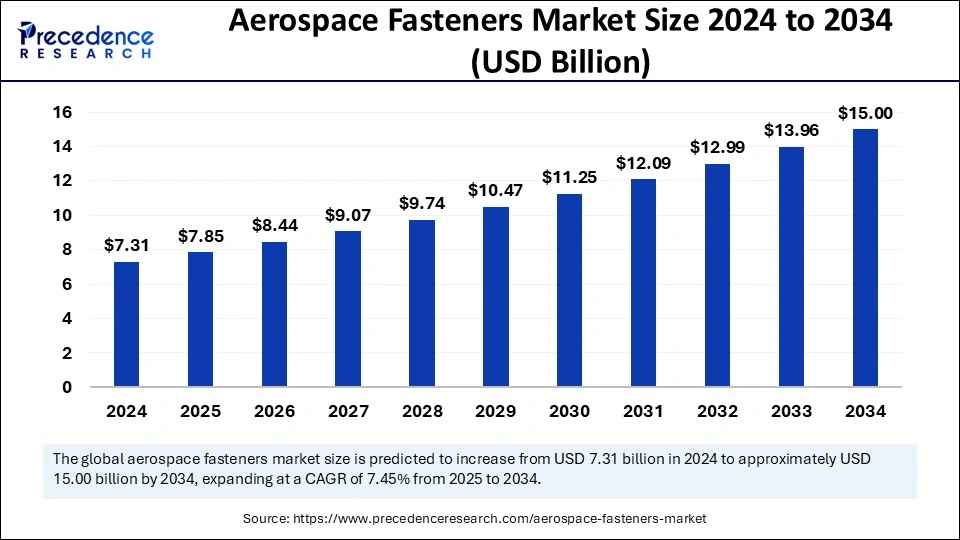
Artificial intelligence plays a vital role in automated production lines where AI-driven automation enhances production efficiency and precision. Furthermore, AI helps in reducing costs and design cycle time, simulation, optimization, maintenance, etc. AI and machine learning contribute to the predictive maintenance and sizing of aircraft components. AI helps to optimize flight performance and improve fuel efficiency. AI can assist in the manufacturing of fast, efficient, and light-weight parts in the aerospace industry. AI and Machine Learning platforms also assist in efficient supply chain management and ensure improved quality control and quality assurance systems.
The U.S. aerospace fasteners market size was exhibited at USD 2.30 billion in 2024 and is projected to be worth around USD 4.81 billion by 2034, growing at a CAGR of 7.65% from 2025 to 2034.
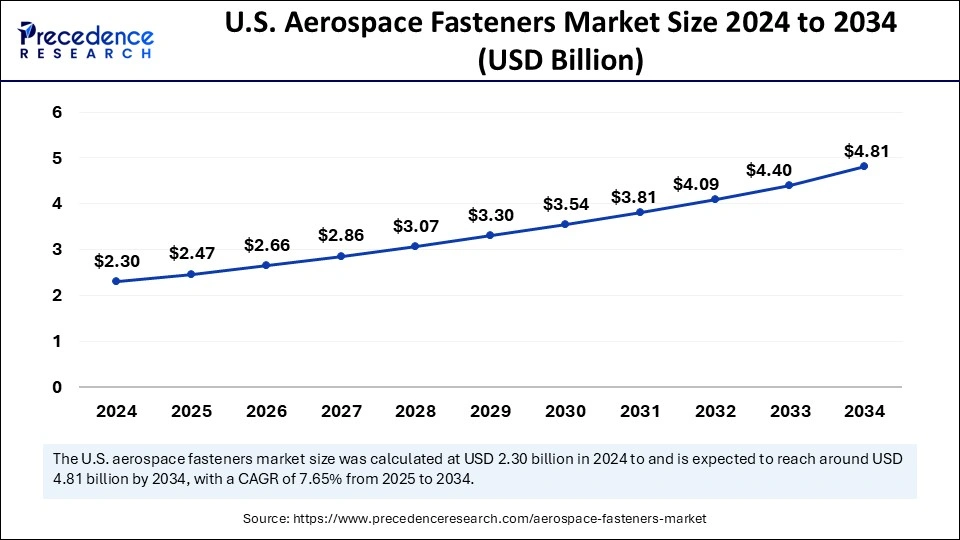
North America dominated the aerospace fasteners market in 2024 due to the presence of leading aircraft manufacturers such as Tetron, Boeing, and Bombardier across this region. The adoption of next-generation manufacturing technologies and increased investments in R&D activities accelerate the market’s growth significantly. The presence of military sectors and leading manufacturers impact the overall positive growth of the market. Lockheed Martin and Boeing are the major American aerospace businesses which highly demand for aerospace fasteners. Furthermore, technological innovations and developments in aircraft technology raised the demand for high-performance fasteners in this region. The U.S. from the North American region plays a vital role in the aerospace industry. The America-based company named Boeing is at the forefront of the aerospace sector. The world’s best-selling commercial aircraft the 737 MAX series of Boeing needs several aerospace fasteners to maintain structural integrity and safety.
Supportive Government Initiatives in the U.S.
The Federal Aviation Administration (FAA) is committed to regulating civil aviation and U.S. commercial space transportation. It also maintains and operates navigation systems and air traffic control for both military and civil aircraft. Moreover, it aims to develop and organize programs for aviation safety and the National Airspace System. The U.S. government offers several design standards and many industries depend on standards from SAE, ISO, and ASTM. The imperial system is a standard and correct measurement system for fasteners in the U.S.
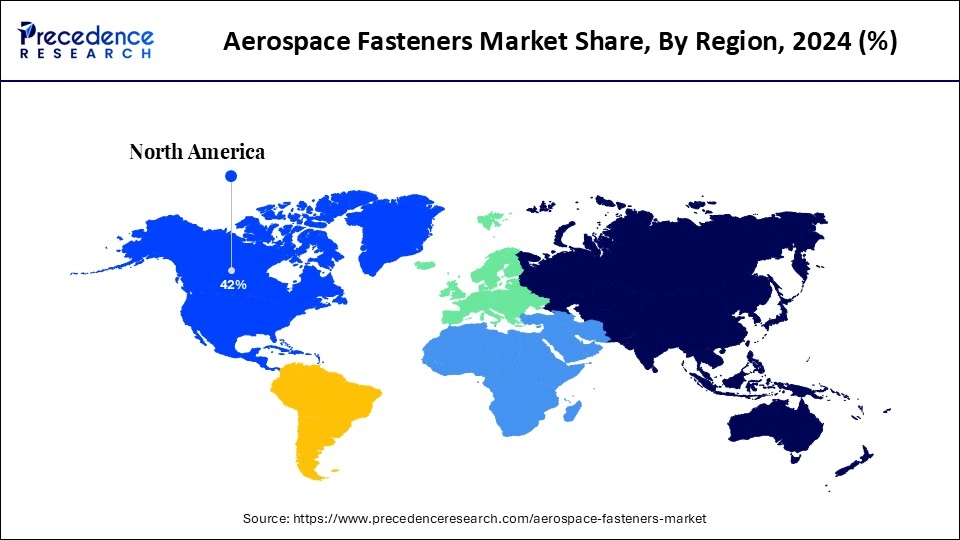
Asia Pacific is observed to be the fastest-growing region in the aerospace fasteners market during the forecast period. This regional growth is attributed to the large number of original equipment manufacturers in North America and Europe. The growing aviation industries in countries like India and China support the growth of the APAC region. The rising disposable incomes of the middle-class public and the increased passenger traffic raise the demand for aeronautical fasteners. China and India uphold the global aviation business in the Asia Pacific region. The Commercial Aircraft Corporation of China (COMAC) aims to develop a narrow-body aircraft named the C919. The C919 model will be competing with popular models such as Airbus A320 and Boeing 737. India introduced the HAL Tejas light combat aircraft and a regional jet which upholds the defense and civil aviation efforts of the country.
Robust Business Association in China
The China Fastener Industry Association is the first industry association dealing with machinery products and is approved by the state economic commission. This association encompasses various companies engaged in fastener production and sales as members. It also collaborates with enterprises offering related appliances, materials, and services related to heat treatment, surface treatment, etc. It plays a vital role in the development, reforming, and revitalization of china fastener industry.
Europe was the second-largest shareholder in 2024 in the aerospace fasteners market and is expected to grow at a steady growth rate in the coming years. The increased demand for aerospace fasteners from developed European countries such as the United Kingdom, France, Russia, Italy, and Germany drives the regional market’s growth significantly. The presence of major aircraft manufacturers such as Airbus SE, Leonardo SPA, and Dassault Aviation supports the market’s expansion in Europe. European countries like Germany, France, and the United Kingdom contribute notably to the aerospace fasteners sector. The region focuses on sustainability and aircraft fuel efficiency to encourage the usage of lightweight materials. Airbus is the major player in this sector which is located in France. The world’s largest passenger airliner the Airbus A380 is a brilliant example of a sophisticated aircraft requiring aerospace fasteners.
Major Industry Players in France
The LISI Aerospace is leading in high-technology aerospace components like fasteners. LISI Aerospace has a smart factory production line in Rugby to enhance productivity and performance. The other French companies like Arconic and B&B Specialties offer a wide range of fasteners like nuts, screws, bolts, latches, etc. for military, aerospace, and aircraft industries. Toulouse is the principal center for aerospace in Europe which encompasses over 500 aerospace companies and research centers.
The aerospace fasteners refer to the hardware components that aid in providing structural integrity to aircraft and spacecraft construction. They are ideal for aviation and space applications. The various types of these components include standard fasteners like screws, bolts, nuts, etc., and specialty fasteners like blind rivets, blind bolts, etc. The extensive utilization of high-grade alloys, titanium, and other advanced materials makes them incredibly strong. These products meet compliance with quality standards like AS9100 to ensure safety and reliability.
| Report Coverage | Details |
| Market Size by 2034 | USD 15.00 Billion |
| Market Size in 2025 | USD 7.85 Billion |
| Market Size in 2024 | USD 7.31 Billion |
| Market Growth Rate from 2025 to 2034 | CAGR of 7.45% |
| Dominated Region | North America |
| Fastest Growing Market | Asia Pacific |
| Base Year | 2024 |
| Forecast Period | 2025 to 2034 |
| Segments Covered | Product, Material, Platform, and Regions |
| Regions Covered | North America, Europe, Asia-Pacific, Latin America and Middle East & Africa |
Expansion of Military Aviation Industries
The rapidly growing military aviation industry with the emerging need for efficient aerospace fasteners drives the growth of the aerospace fasteners market. The high preference for defense capabilities by countries and advanced activities in the military aviation industry boosts the market’s expansion globally. Moreover, the upgradation of traditional aircraft into modernized forms by applying modern technologies accelerates the significance of the market. The introduction of more efficient, high-strength, and corrosion-resistant fasteners upsurges the global adoption of these products and services in different sectors. In March 2024, the F-35 Joint Strike Fighter Program reported full-rate production showcasing good performance and dependability. Furthermore, the growing demand for high-performance fasteners is driven by continuous technological advancements, increased defense budgets, and new military aircraft innovations.
Dynamic Cost-Effectiveness of Raw Materials
The high demand for raw materials due to the emerging need for high-performance materials such as alloys, aluminum, and titanium impacts the costs of these materials. Apart from this, geopolitical concerns, mining circumstances, and product supply imbalance can hamper the aeronautical applications of these materials. The increased costs associated with titanium and titanium dioxide in China in the year 2023 can impose challenges in front of consumers from different sectors.
Expansive Reach of Commercial Aviation
The growing shift of people towards air travel and the commercial aviation sector drives the growth of the aerospace fasteners market significantly. The developing economic countries are raising the need for new aircraft and aerospace fasteners. The excellent role of these fasteners in ensuring strength, structural integrity, maintenance, airplane assembly, and safety boosts their expansive reach in the global market. Moreover, a strong economy, great family incomes, a growing population, and demographic characteristics drive the overall adoption of these products globally. The developments in airline fleets result in increased air travel incidents in new aircraft. The presence of major aircraft manufacturers like Airbus and Boeing imposes a high demand for aerospace fasteners in the future. China demands new aeroplanes by 2040 and India holds successive air travel experiences.
By product, the rivets segment dominated the aerospace fasteners market in 2024 due to the growing utilization of rivets in aircraft manufacturing. The various advantages of rivets over other fasteners make them the preferred choice for consumers. They ensure high reliability and rigid connectivity to aerospace structures. They provide high safety to passengers through strong manufacturing and assembly of aerospace structures.
The essential features of rivets in the aerospace industry including strength make them important in aeroplane building. The provided structural integrity by rivets is crucial for safety and performance. The potential ability of rivets to evenly distribute loads reduces the risk of material failure. Advancements in riveting technology including improved rivet designs and automated riveting systems have enhanced the efficiency and precision of aircraft operations.
By product, the screws segment is anticipated to be the fastest-growing in the aerospace fasteners market over the forecast period. This segmental growth is driven by the potential features of these materials like adaptability and the ease of installation and removal. They offer strong joints and are adjustable which allows maintenance, repair, and modification for improved aircraft functioning.
Moreover, the wide utilization of screws in both commercial and military aircraft for several purposes drives their demand in the market. They offer fastening interior panels, avionics components, vital systems, and access panels that need regular maintenance or replacement. The easy removal and reinstallation of screws without causing structural damage boosts their adoption globally.
By material, the aluminum segment led the aerospace fasteners market in 2024 because of its exceptional properties, including lightweight composition, corrosion resistance, and a high strength-to-weight ratio. These properties make aluminum an ideal material for aerospace, spacecraft, defense, or military applications. These properties aid in reducing the weight of aircraft, boosting fuel efficiency, and reducing operational expenses. The wide utilization of aluminum fasteners in commercial and military aircraft drives the growth of the aluminum segment. The low cost and ease of manufacturing related to aluminum fasteners boost their demand in the market. The advancements in aluminum alloys also enhance performance and mechanical properties in complex situations.
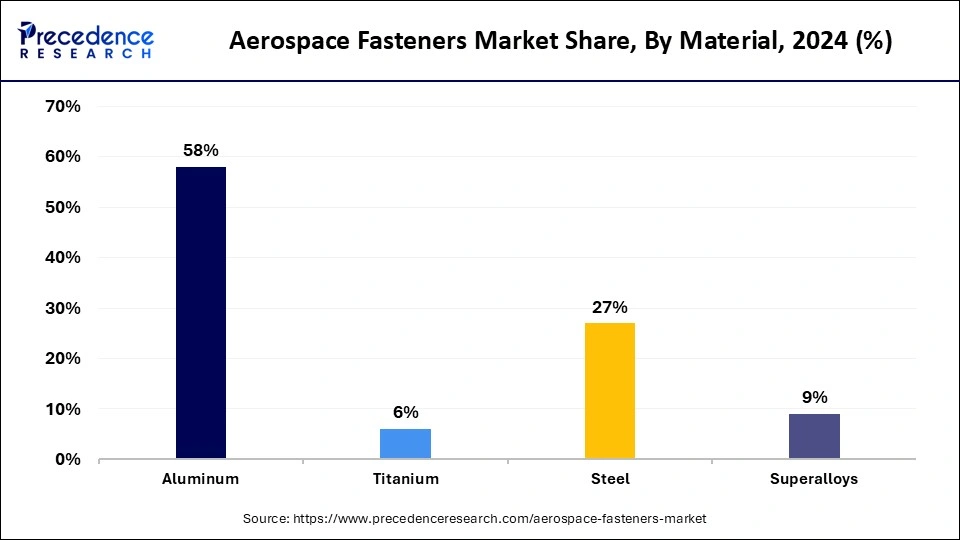
The R&D efforts in aluminum metallurgy and the emergence of innovative manufacturing techniques drive the segmental growth in the market. The recyclable nature and sustainability efforts related to this material boost the growth of the aluminum segment. Advanced techniques such as additive manufacturing promote the increased adoption of aluminum fasteners in the aerospace industry sector.
By material, the titanium segment is observed to be the fastest-growing in the aerospace fasteners market during the forecast period. This segmental growth is due to the rising need for highly rigid and reliable fasteners for aerospace structure manufacturing. The growing demand for superalloys also boosts segmental growth in the market. The numerous advantages of titanium fasteners such as high rigidity in extreme conditions, low weight, and high heat resistance capacity drive the growth of the titanium segment.
Moreover, it offers high strength, corrosion resistance, low density, and adaptability to high temperatures. The vast applications of titanium in aerospace industries result in high performance and reliability. Furthermore, titanium fasteners including commercial jets like Boeing 787 Dreamliner and Airbus A350 and military aircraft like the F-35 Lightning II are in high demand due to high performance.
By platform, the fixed-wing aircraft segment dominated the aerospace fasteners market in 2024 due to their vast applications in commercial, general, military, and business aircraft. They are widely expanding due to the rising demand for modern-generation fixed-wing aircraft for carrying passenger loads and cargo. The huge adoption of these platforms in commercial aircraft drives the expansion of the fixed-wing aircraft platform. The capability to travel a long distance at high altitudes without the need of refueling makes them suitable for passengers and transport goods. The better flight stability even under certain weather conditions such as strong winds, thunderstorms, and turbulence showcases the exceptional quality of these aircraft.
By platform, the rotary-wing aircraft segment is expected to grow rapidly in the aerospace fasteners market in the coming years. This growth is driven by the excellent advantages of these aircraft such as better maneuverability, vertical takeoffs and landings, and an ability to hover in place. The enhanced accessibility to these aircraft or helicopters in generally inaccessible areas to planes drives their importance significantly. The availability of assets in certain emergency services also boosts their adoption in the market. They offer assistance related to ground surveillance, assessment, and firefighting which makes them capable of performing operations efficiently.
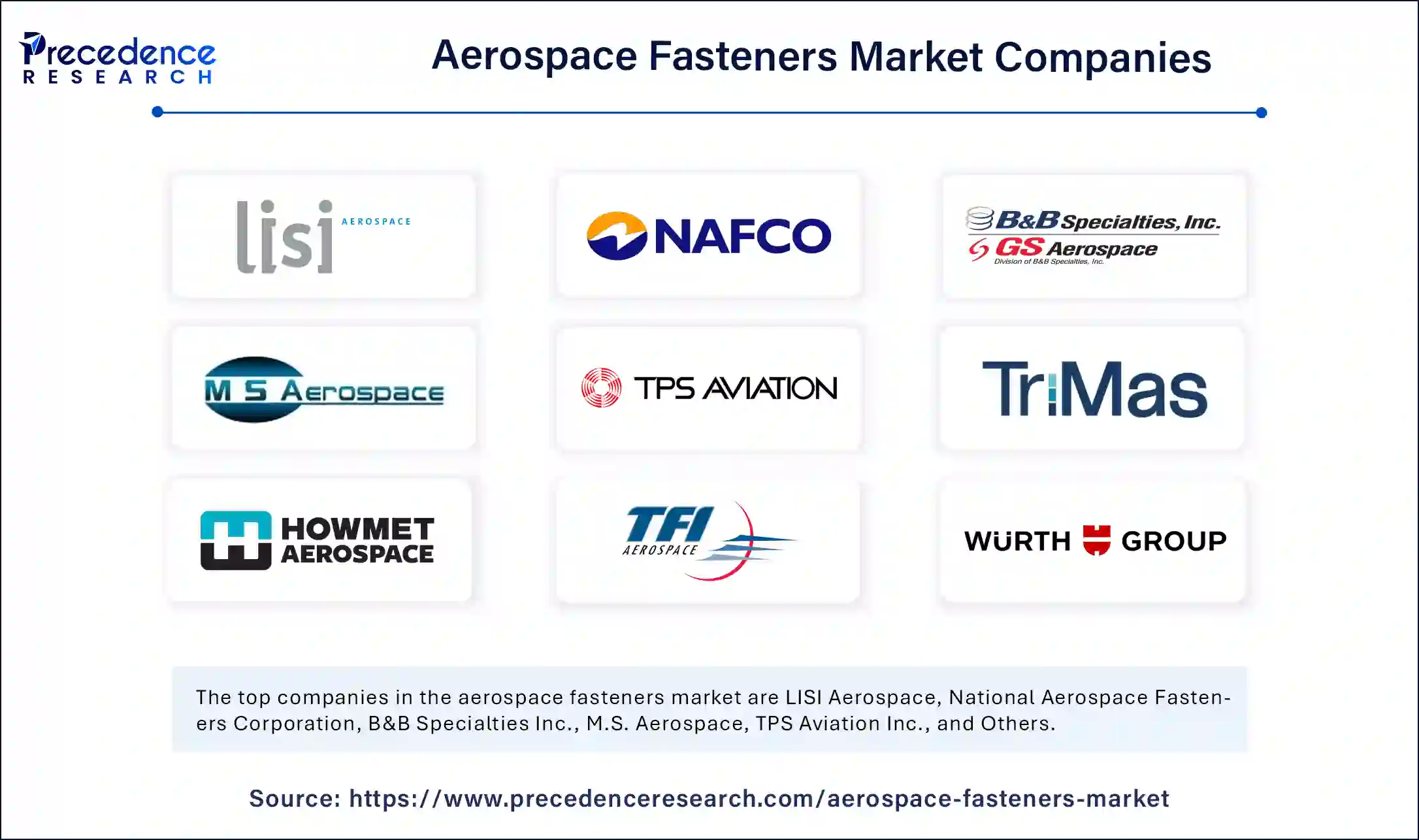
By Product
By Material
By Platform
By Region
For inquiries regarding discounts, bulk purchases, or customization requests, please contact us at sales@precedenceresearch.com
No cookie-cutter, only authentic analysis – take the 1st step to become a Precedence Research client
July 2024
November 2024
February 2025
November 2023